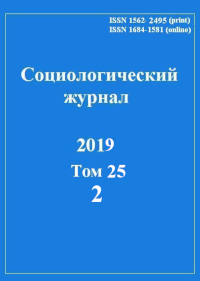Коммуникативные сбои и способы их преодоления в роботизированном телефонном опросе
Аннотация
Литература
Гофман И. Анализ фреймов: эссе об организации повседневного опыта / Пер. с англ. Р.Е. Бумагина, Ю.А. Данилова, А.Д. Ковалева, О.А. Оберемко; Под ред. Г.С. Батыгина, Л.А. Козловой. М.: Институт социологии РАН, 2003. — 752 с.
Зильберман Н.Н. Технологии виртуальных собеседников и формы речевого взаимодействия // Гуманитарная информатика. 2009. № 5. С. 80–85.
Корбут А.М. «Простите, я никак не могу понять»: способы реагирования на непонимание во взаимодействии человека и робота // Laboratorium: Журнал социальных исследований. 2018. Т. 10. № 3. С. 57–78. DOI: 10.25285/2078-1938-2018-10-3-57-78
Рогозин Д., Ипатова А., Галиева Н. Стандартизированное (телефонное) интервью. М.: Пункт, 2018. — 416 с.
Сапрыкина В.В. Жизнь в социальных сетях — Chatbots // Вестник современных исследований. 2018. № 12. С. 237–239.
Сергеев С.Ф., Сергеева А.С. Проблема квазисоциального интерфейса в робототехнических средах // Робототехника и техническая кибернетика. 2014. № 2. С. 23–28.
AAPOR. An Evaluation of the Methodology of the 2008 Pre-Election Primary Polls. Deerfield, IL: American Association for Public Opinion Research, 2009 [online]. Accessed 01.11.2018. URL:
Boren R.W., Moor W.C. Some appealing applications of interactive voice response // Proceedings of the Human Factors and Ergonomics Society Annual Meeting. 2001. Vol. 45. No. 5. P. 557–561. DOI: 10.1177/154193120104500503
Couper M.P. New developments in survey data collection // Annual Review of Sociology. 2017. Vol. 43. P. 121–145. DOI: 10.1146/annurev-soc-060116-053613
Couper M.P. The future of modes of data collection // Public Opinion Quarterly. 2011. Vol. 75. No. 5. P. 889–908. DOI: 10.1093/poq/nfr046
Fomby P., Sastry N. Adolescents using interactive voice response technology // Methods, Data, Analyses. 2019. Vol. 13. No. 1. P. 91–110.
Gardner-Bonneau D., Delogu C., Green Ch., et al. Interactive voice response (IVR) systems as automatic speech recognition (ASR) comes of age // Proceedings of the Human Factors and Ergonomics Society Annual Meeting. 1998. Vol. 42. No. 4. P. 444–447. DOI: 10.1177/154193129804200409
Kreuter F., Presser S., Tourangeau R. Social desirability bias in CATI, IVR, and Web surveys: The effects of mode and question sensitivity // Public Opinion Quarterly. 2008. Vol. 72. No. 5. P. 847–865. DOI: 10.1093/poq/nfn063
Lasswell H.D. The structure and function of communication in society // The communication of ideas / Ed. by L. Bryson. New York: Harper and Brothers, 1948. P. 37–51.
Peterson G.E. Automatic speech recognition procedures // Language and Speech. 1961. Vol. 4. No. 4. P. 200–219.
Schramm W. How communication works // The process and effects of mass communication / Ed. by W. Schramm. Urbana, Il: University of Illinois Press, 1954. P. 3–26.
Schramm W. The nature of communication between humans // The process and effects of mass communication / Ed. by W. Schramm, D.F. Roberts. 4th ed. Urbana, Il: University of Illinois Press, 1977. P. 3–54.
Shannon C., Weaver W. The mathematical theory of communication. Urbana, IL: University of Illinois Press, 1949.
Silver N. Which polls fared best (and worst) in the 2012 presidential race // New York Times. 2012. 10 November [online]. Accessed 26.03.2019. URL:
Tourangeau R., Steiger D.M., Wilson D. Self-administered questions by telephone: Evaluating interactive voice response // Public Opinion Quarterly. 2002. Vol. 66. No. 2. P. 65–278. DOI: 10.1086/340029
Voskuhl A. Humans, machines, and conversations: An ethnographic study of the making of automatic speech recognition technologies // Social Studies of Science. 2004. Vol. 34. No. 3. P. 393–421. DOI: 10.1177/0306312704043576
Все права на статью принадлежат авторам. Авторы передают права на использование статьи, в том числе на использование статьи в открытом доступе, издателю журнала на условиях неисключительной лицензии (Авторское соглашение (публичная оферта))
Принятием условий этого договора автором считается передача им материалов в редакцию через официальный сайт журнала ("Отправить рукопись") или через электронную почту редакции.











